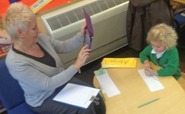Years Foundation Stage and improve practice, says Adrian Hickman.

For many early years practitioners, collecting evidence of children's learning often involves Post-it notes, stickers, scraps of paper and digital cameras. However, at Rivers Primary Academy (formerly known as Green Rock Primary School), our approach not only saves time, paper and ink but also benefits our practice.
 The system was pioneered at Walsall's Leamore Primary, where I completed my NQT year, and this system also won the school the Naace Impact Award in 2012, Early Years Foundation Stage (EYFS) Category. After using the approach successfully for a year at Leamore, I was keen to implement it at Rivers Primary, where I am early years co-ordinator.
The system was pioneered at Walsall's Leamore Primary, where I completed my NQT year, and this system also won the school the Naace Impact Award in 2012, Early Years Foundation Stage (EYFS) Category. After using the approach successfully for a year at Leamore, I was keen to implement it at Rivers Primary, where I am early years co-ordinator.
Register now to continue reading
Thank you for visiting Nursery World and making use of our archive of more than 35,000 expert features, subject guides, case studies and policy updates. Why not register today and enjoy the following great benefits:
What's included
-
Free access to 4 subscriber-only articles per month
-
Unlimited access to news and opinion
-
Email newsletter providing activity ideas, best practice and breaking news
Already have an account? Sign in here









